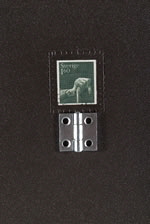| |
Helen MacAlister
Hutton's Rock
10 April - 16 May 2002
LONDON Front Room

     
A recent visit to Helen's studio was conceptual. All the canvases were
stacked against the wall, but their contents were consigned entirely to a set of lime green files. The artist arranged the bare canvases on the floor. Small, laminated images were floated onto their surfaces. Notebooks and books of poetry with flagged pages were drawn from a pile. Every aspect of each painting existed in her mind's eye, mapped out, pared down, edited. She 'read' us through the exhibition.
Language oral and visual is central to Helen's art. She stitches words
and laminated images to canvas, allowing one idea to chase another. Sometimes the 'story' a quote from a poet, an old proverb or simply a beautiful line read and noted down accompanies a work as an attendant label evocatively linked to the colour, form and image of the painting.
Bottom Drawer depicts a chest of drawers, the lowest one open. Its 'story' is a quote from a young Scottish writer, Des Dillon: "Septic wants to cry. I know cos his eyes look the same as mine when I want to cry but I can't. All the cryin runs down the inside of yer face an loads up yer bottom lip. Then yer bottom lip starts tremblin wi the weight. Ma Da calls it the bottom drawer bein out".
Why Hutton's Rock? This figure of the 18th century Scottish Enlightenment is known as the father of geology. His prescient book, Theory of the Earth is based on a reading of the earth's history through rock sections on Salisbury Crags - Arthur's Seat - and his theory of
permanent flux has been a source of inspiration for many artists and
scientists alike.
An illustrated catalogue accompanies the exhibition with an essay by Prof. Duncan Macmillan


|
|